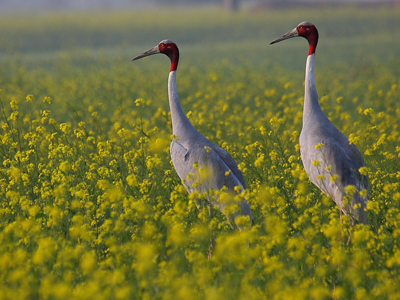
By Kelly Maguire, ICF Assistant Curator
Indian Sarus Cranes (Grus antigone antigone) are one of three subspecies of Sarus Cranes (Grus antigone) recognized by the International Union for Conservation of Nature and Natural Resources (IUCN). Sarus Cranes are categorized as Vulnerable on the IUCN Red List of Threatened Species, which in general means that the population is decreasing in the wild and therefore “facing a high risk of extinction in the wild” (IUCN).
Although ICF has bred Indian Sarus Cranes in the past, we haven’t done so since 1996. Recently, we learned from the Sarus Crane studbook keeper that Majnu, our 51-year-old male, along with Chandini, a 12-year-old female on loan to ICF from the Gulf Breeze Zoo in Florida, are not only a good genetic pair, but there is a need for their offspring in captivity.
Majnu and Chandini have been on display at ICF since 2005. Because Chandini was still fairly young at three years old when we put the pair together, we did not expect successful breeding from them for several years. We were pleasantly surprised when Chandini laid an egg that first breeding season, although the egg was infertile. The pair continued to lay in subsequent breeding seasons, but all of the eggs were infertile. For an unknown reason, in 2009, Majnu began breaking the eggs. It was at this point that aviculturists began different behavior management changes to try and deter continued egg breaking. Unfortunately, these techniques did not work with Majnu, so in 2013 we began separating the birds when Chandini showed signs of egg laying. After recovering an intact egg, the pair was put back together. By getting intact eggs in 2013, aviculturists were able to confirm that the pair still did not produce fertile eggs and that to successfully breed this pair we would need to do artificial insemination.
With Majnu past 50 years of age, it was decided to do an all-out push to get fertile eggs and possibly raise a chick in 2014. In order to do this, aviculturists began more intense behavior observations on the pair to try and determine when Chandini was getting ready to lay. Artificial insemination was also started a week before we expected Chandini to lay her first egg. Although we have been able to get samples from Majnu, they have not been of high quality. The first intact egg that we obtained this year after separating the pair was unfortunately infertile. The next two eggs were laid on July 19 and 22, and early this week we confirmed that both of these eggs are fertile!
Due to the time of year, we do not have surrogate incubating birds (our other breeding pairs are no longer incubating), so both fertile eggs will be incubated by machine incubators. Although we will keep a close eye on the eggs, hatchability is lower for eggs incubated this way (Update: As of August 11 both eggs are doing well, with hatch dates projected for August 20 and 23). Our hope is to give Chandini, who is still separated from Majnu but is incubating a fake egg, one of the eggs once it begins to hatch. After the egg has hatched, we will watch how Majnu interacts with the chick through the fence and possibly put him back in with Chandini and the chick. If the second fertile egg makes it to hatching, the Denver Zoo has shown interest in receiving this egg to hatch under their pair of Indian Sarus Cranes.
Photo: In addition to supporting healthy captive Sarus Crane populations through our breeding programs, in the field ICF’s SarusScape program focuses on the landscapes that sustain remaining wild Sarus Cranes in northern India (learn more about our work in the Upper Ganges River basin). Photo by K.S. Gopi Sundar
